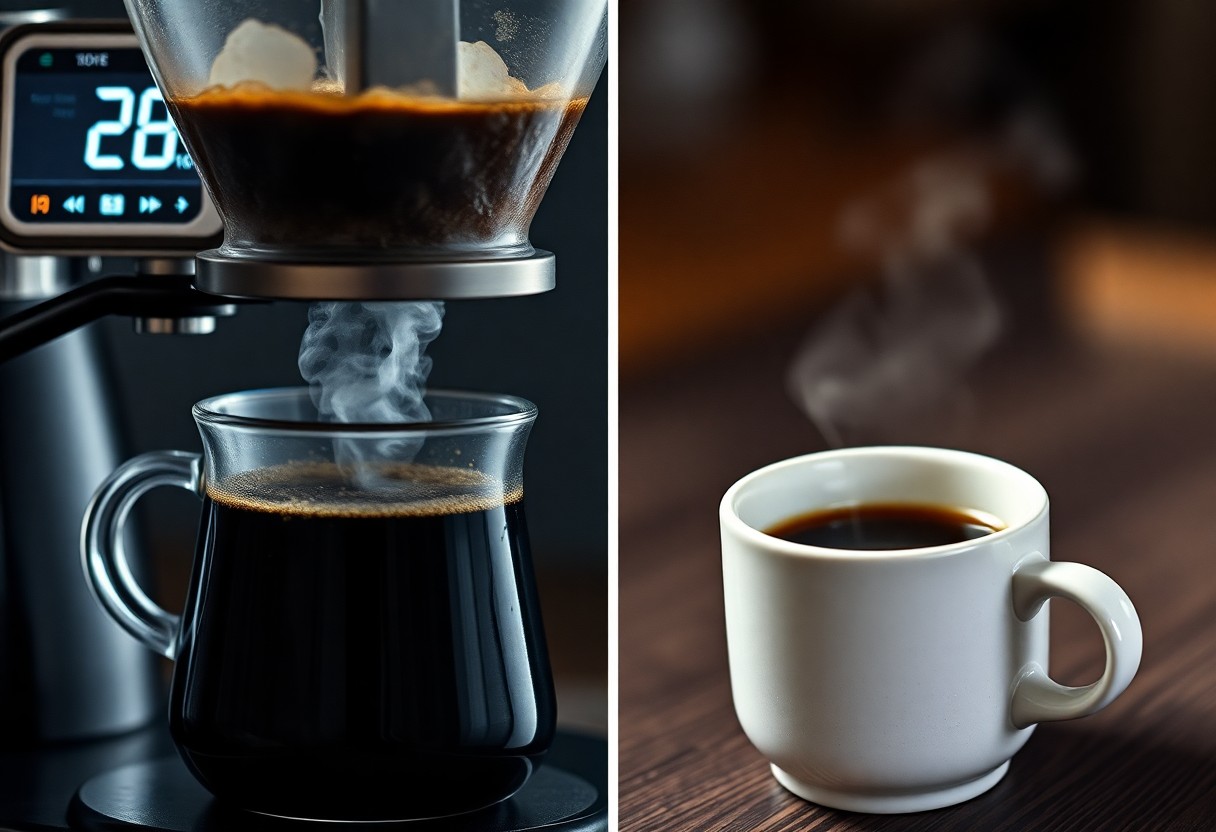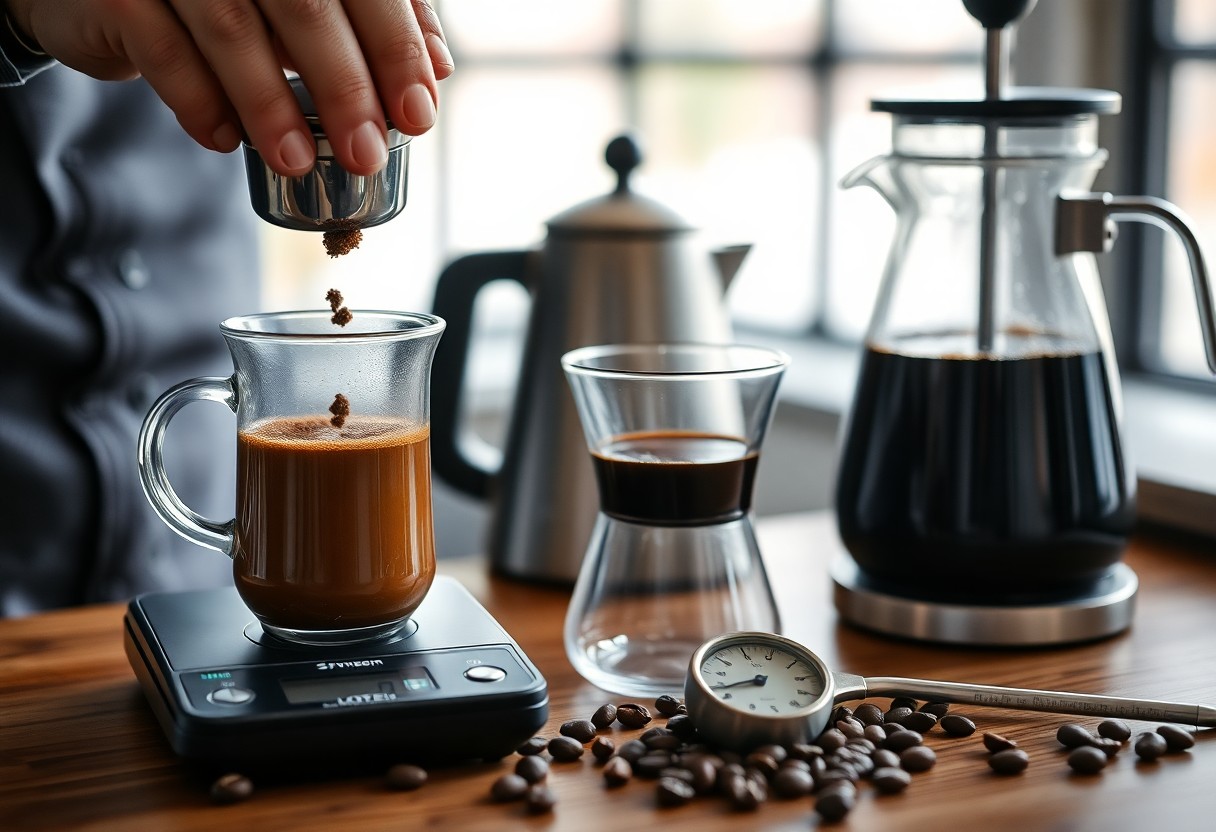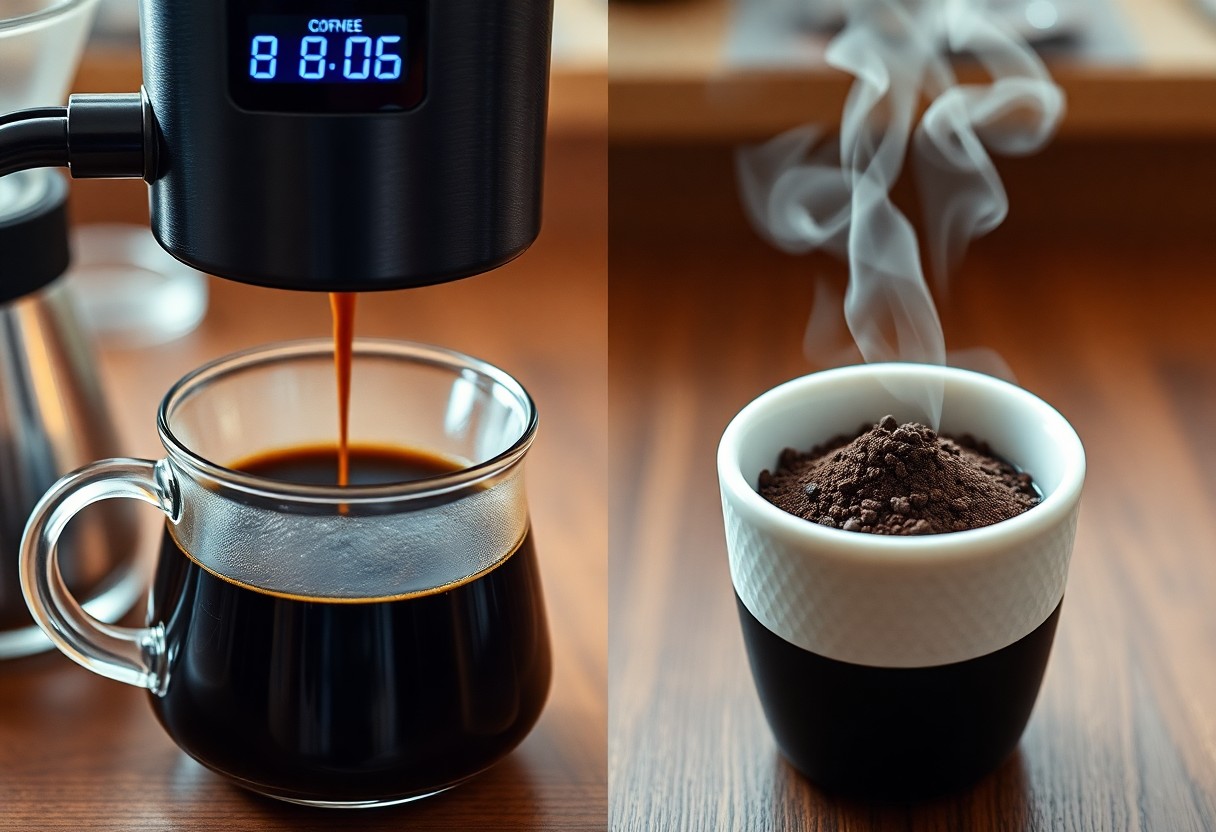With even the slightest variation in your brew temperature, you can dramatically alter the flavor profile of your coffee. As you explore the intricate world of brewing, these tiny adjustments can unlock hidden notes in your drink or lead to undesirable bitterness. In this post, you’ll learn how temperature swings impact extraction and what that means for your daily cup. By mastering this aspect of brewing, you can enhance your coffee experience and appreciate the full spectrum of flavors that your beans have to offer.
Key Takeaways:
- The temperature at which coffee is brewed can dramatically impact the extraction of flavors, resulting in subtle or pronounced shifts in the final taste.
- Minor fluctuations in brew temperature can enhance or diminish specific notes, making the coffee taste more acidic, bitter, or balanced.
- Understanding and controlling brew temperature can lead to a more consistent and enjoyable coffee experience, allowing for the exploration of various flavor profiles.
The Temperature Spectrum: A Flavorful Journey
Your taste experience starts with the myriad temperatures that affect coffee extraction. The range of brew temperatures spans from extractive zones below 190°F, which yield mellow, subtle flavors, to those above 205°F, where bitter and astringent notes begin to dominate. Understanding this spectrum will enable you to navigate the flavors in your cup more skillfully.
Temperature Range | Flavor Characteristics
— | —
Below 190°F | Mellow, sweet, and fruity notes emerge
190°F – 205°F | Balanced flavor profile with a mixture of acidity and body
Above 205°F | Bitter and astringent, overwhelming other flavors
The Impact of Heat on Coffee Chemistry
Heat influences coffee’s chemical reactions, affecting the extraction of oils, acids, and sugars. At lower temperatures, soluble compounds dissolve more slowly, leading to softer profiles, while higher temps expedite extraction, pushing out bitterness and creating a heavier body. You’ll notice that even a slight variation, such as a difference of 5°F, can shift the balance of your brew significantly.
Discovering Ideal Brew Temperatures
Finding your ideal brew temperature can elevate your coffee experience immensely. Typically, most brewing methods thrive between 195°F and 205°F. Experimenting within this range allows you to explore and fine-tune the unique flavors in your beans. Depending on the roast profile and origin, aiming for different temperatures can unveil a coffee’s hidden nuances.
Brewing Method | Recommended Temperature
— | —
French Press | 200°F
Pour Over | 195°F – 205°F
Espresso | 190°F – 205°F
Cold Brew | 50°F – 65°F
Different brewing methods require specific temperature ranges for optimal extraction. For instance, French press coffee often hits the sweet spot at around 200°F to highlight its rich body and flavor complexity. In contrast, cold brew relies on lower temperatures, which emphasize sweet notes while minimizing acidity. Adjusting your methods accordingly not only refines your brew but also elevates your appreciation for coffee’s delicate flavor spectrum.
Flavor Profile Revolution: The Role of Temperature Variability
| Temperature Variation | Impact on Flavor Profile |
|---|---|
| Below 195°F (90°C) | Under-extraction, resulting in sour notes and low body. |
| 195°F – 205°F (90°C – 96°C) | Ideal range for balanced extraction of flavors. |
| Above 205°F (96°C) | Over-extraction, leading to bitterness and astringency. |
How Minor Adjustments Create Major Differences
Temperature adjustments of just a few degrees can rework the entire coffee experience. For instance, brewing at 200°F instead of 205°F may coax aromatic compounds to release sooner, enriching your cup with nuanced flavors you might have otherwise missed. Even a slight shift can go from bitter to perfectly balanced, transforming your daily brew into something exceptional.
Balancing Acidity, Sweetness, and Bitterness
Achieving harmony in your coffee relies on a delicate balance of sweetness, acidity, and bitterness, all of which are influenced directly by temperature. Your brewing temperature can enhance or mask these flavors, creating an experience that caters to your personal palate.
When you focus on balancing these flavor components, you’ll discover how temperature sways their dominance. For example, slightly increasing brew temperature can amplify sweetness and acidity, resulting in a brighter cup, while a cooler brew may suppress these characteristics in favor of a smoother, more mellow profile. Exploring and adjusting temperatures allows you to identify your preferred flavor accounts, offering a richer, more rewarding coffee journey. Understanding these dynamics leads to not only better brewing but to a more refined appreciation of every cup.
Brew Temperature Swings – Sensitivity to Temperature Changes
Your choice of brewing method can dramatically influence how sensitive your coffee is to temperature fluctuations. Different techniques require varying extraction times and temperatures, leading to distinct profiles. For instance, the precision of pour-over differs significantly from the immersion process used in French press, altering flavor outcomes with just minor temperature adjustments. The table below highlights these differences:
| Brewing Method | Temperature Sensitivity |
|---|---|
| Pour-Over | Highly sensitive; minor temp changes can shift flavor balance. |
| French Press | Moderately sensitive; temp swings affect body and brew time. |
Pour-Over vs. French Press: A Temperature Comparison
Pour-over coffee, requiring precise temperatures between 195°F and 205°F, showcases the intricate impact of thermodynamic changes on flavor. Even minor variations while pouring can lead to over-extraction or under-extraction, altering taste profiles significantly. French press, with its longer extraction times and more forgiving temperature range, generally results in a fuller body but retains some sensitivity to heat adjustments. The table below compares their temperature-related attributes:
| Aspect | Pour-Over | French Press |
|---|---|---|
| Ideal Temperature | 195°F – 205°F | 190°F – 200°F |
| Extraction Time | 2-4 minutes | 4-5 minutes |
| Taste Sensitivity | Highly sensitive | Moderately sensitive |
The Influence of Thermodynamics in Espresso Extraction
Espresso extraction relies heavily on thermodynamics, regulating heat transfer during brewing. The optimal brewing temperature for espresso ranges between 190°F and 205°F. A drop in temperature by just a few degrees can lead to sour tastes from incomplete extraction, while excessively high temps can produce bitter flavors through over-extraction. Additionally, the pressure applied during espresso brewing affects how grounds release soluble compounds, with temperature variations exacerbating the issue. Crafting the perfect espresso thus demands attention not just to pressure but also to maintaining a consistent, optimal brewing temperature.

Precision vs. Intuition: Crafting the Perfect Cup
Achieving a perfect cup of coffee involves striking a balance between precision and intuition. When you meticulously monitor brew temperatures, every degree can profoundly influence the extraction process and flavor nuances, while also allowing your instinctual adjustments to come into play based on taste and experience. Harnessing both aspects creates a brewing experience that is both artful and science-driven, resulting in a satisfying cup tailored to your preferences.
Tools and Techniques for Temperature Control
| Tool/Technique | Description |
|---|---|
| Thermometer | Accurately measures water temperature before brewing. |
| Kettle with Temperature Control | Allows you to set exact brewing temperatures for consistency. |
| Brew Timer | Helps manage extraction time, crucial for flavor balance. |
| Digital Scale | Measures coffee and water accurately for precise ratios. |
Tuning Your Palate: The Art of Temperature Tasting
Engaging in temperature tasting teaches you how various brewing temperatures affect flavor and mouthfeel. As you explore different ranges—such as brewing at 180°F versus 200°F—you’ll discern the subtleties that emerge, honing your palate to pick up on the delicate balance between acidity, sweetness, and bitterness.
| Temperature Range | Tasting Notes |
|---|---|
| 160°F – 180°F | Sweetness is pronounced; acidity can be muted. |
| 180°F – 200°F | Balanced flavors; optimal extraction is achieved. |
| 200°F – 210°F | Greater bitterness; flavors can become harsh. |
In the journey of honing your tasting skills, experimenting with varying temperatures opens up an exciting world of flavors. When tasting at different temperatures, you might find that the same coffee can showcase distinct characteristics. Engaging in temperature tasting not only enhances your appreciation for coffee but also empowers you to identify your ideal brewing range, ultimately leading to your perfect cup.
| Focus Area | Effect on Flavor Profile |
|---|---|
| Swirl Method | Encourages flavor release and enhances aroma perception. |
| Slow Sips | Allows full appreciation of nuanced flavors at different temperatures. |
| Blind Tasting | Eliminates biases, enabling an objective assessment of temperature influence. |

Real-World Implications: Craft Coffee and Consumer Experience
Your coffee experience extends far beyond the first sip; it’s influenced by every detail that goes into your cup, especially brew temperature. The increasing competition among coffee shops means that understanding how temperature impacts flavor is vital for keeping customers satisfied. A slight temperature variation can drastically alter taste notes, leading to either an underwhelming or memorable experience. Craft coffee has evolved into a delicate art form where mastery of temperature can differentiate brands and elevate consumer expectations, making it imperative to navigate these small yet significant adjustments.
The Science Behind Coffee Shop Standards
Most coffee shops adhere to strict brewing guidelines to provide a consistent experience, typically recommending brew temperatures between 195°F to 205°F. This range has been scientifically determined to extract optimal flavor compounds while minimizing the risk of bitter or underdeveloped notes. For espresso, temperatures are often closer to 200°F, ensuring that all complex flavors present in the beans are accurately conveyed to the cup. These established temperatures form a baseline for quality, vital for both coffee novices and aficionados alike.
Educating Consumers: The Brew Temperature Dialogue
Many consumers may not grasp how temperature affects their coffee’s nuances. Engaging them in conversations about brew temperature allows you to enrich their appreciation of your coffee offerings. For instance, many believe that hotter coffee equals better flavor, but cooler temperatures might actually accentuate subtle notes in certain blends. By emphasizing education within your shop and providing informative tasting sessions focused on temperature variations, you deepen customer connections and enhance their overall experience.
| Engagement Method | Informative Tasting Sessions |
| Temperature Impact | Enhances Flavor Nuance |
| Common Misconception | Hotter is Always Better |
| Customer Benefit | Informed Choices, Richer Experience |
Fostering a dialogue about brew temperature empowers you to demystify coffee for your customers. Instead of adhering to preconceived notions regarding temperature, you can present them with evidence through tastings and discussions. By showcasing how slight temperature adjustments can enhance or detract from flavors, you help customers recognize that their preferences are valid and legitimate. This approach not only builds loyalty but also positions your coffee shop as a place of knowledge and craft, rather than just a transactional experience.
To wrap up
Drawing together the insights on brew temperature swings, you can see how even minor adjustments can significantly alter your coffee’s flavor profile. By understanding the science behind temperature and extraction, you can better control your brewing process to achieve your desired taste. Pay attention to the small changes in your brewing environment, as they can enhance or detract from your coffee experience. Ultimately, this knowledge empowers you to create the perfect cup tailored to your unique palate.
FAQ
Q: What are brew temperature swings and how do they occur?
A: Brew temperature swings refer to variations in water temperature during the brewing process, which can happen due to equipment inconsistencies, environmental factors, or user error. These changes can shift the extraction of flavors from the coffee grounds, resulting in a different taste profile in the final cup.
Q: How do small temperature variations impact flavor extraction?
A: Small changes in temperature can significantly affect how different compounds within the coffee are extracted. Higher temperatures tend to extract sweeter and bolder flavors, while cooler temperatures can result in a more acidic and bright profile. As a result, a shift of just a few degrees can alter the balance and overall taste experienced in the brew.
Q: Is there an ideal temperature range for brewing coffee?
A: While the optimal range can vary based on the coffee type and brewing method, a general recommendation is between 195°F to 205°F (90°C to 96°C). Staying within this range helps ensure balanced extraction, although experimenting with slight variations can yield interesting flavor notes based on personal preference.
Q: How can I control and maintain a consistent brew temperature?
A: To achieve a stable brew temperature, consider using temperature-controlled kettles, preheating your brewing equipment, and monitoring water temperature with a thermometer. Additionally, familiarizing yourself with your equipment’s idiosyncrasies can aid in anticipating and adjusting for any temperature shifts that may occur during brewing.
Q: What should I look for in my coffee’s flavor profile when experiencing temperature swings?
A: If you notice changes in the flavor profile due to temperature swings, pay attention to the various notes present in your coffee. For instance, if the brew tastes overly bitter, it may indicate a temperature that was too high. Conversely, if it tastes too sour or acidic, the temperature might have been too low. Identifying these shifts can guide you in fine-tuning your brewing process.
